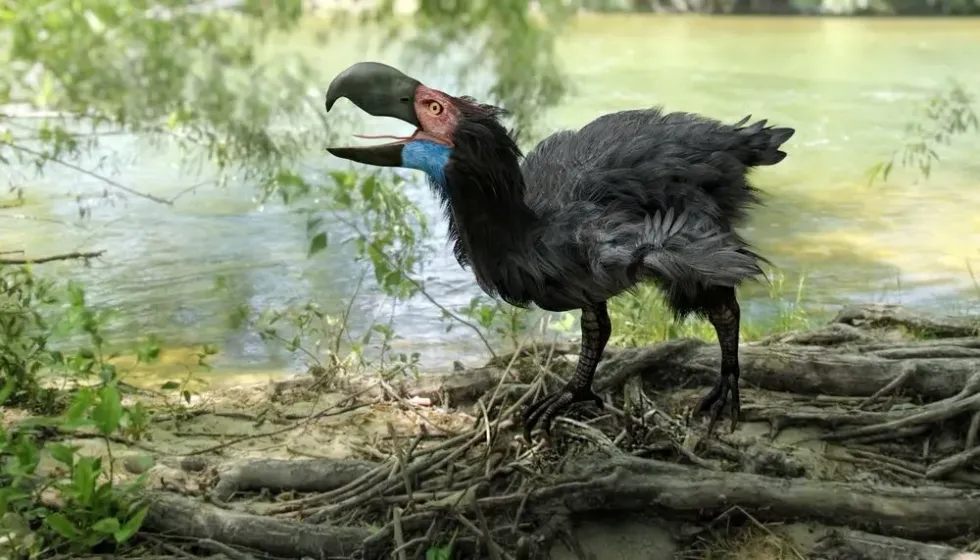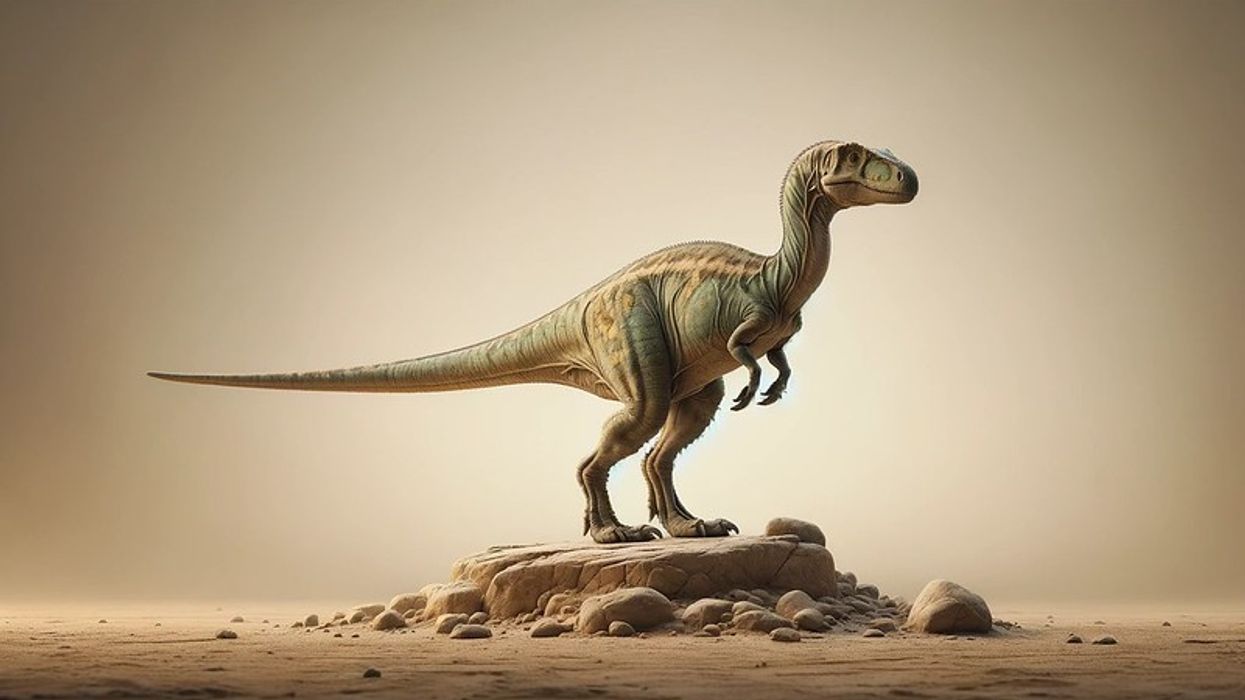Diatryma belongs to the phylum Chordata, subclass Neornithes, and order Gastornithiformes. They were flightless birds from the carnivorous category.
Diatryma was discovered in Wyoming first by Edward Drinker in the year 1876. Diatrymameans ‘through a hole’ and that was deduced for this bird only because they had large foramina (perforations).
They came after the theropod dinosaurs after their extinction. They were large birds with short necks yet very powerful but the forelimbs were functionless and they had small wings; all this is reminiscent of the T. rex.
Diatrymaand T. rex is often concluded to have a similar lifestyle and diet. Diatryma (Gastornis) was like a fierce animal that used to prey on sick, young, and old individuals because they had a minimum level of competition.
Some paleontologists are of the opinion that they were herbivorous animals, who used to graze. Most of the best fossils of Diatrymaare well preserved in the Willwood Formation in northeastern Wyoming in a museum.
You can also check out Xiphactinus and Confuciusornis to get more insights about related animals.
Diatryma Interesting Facts
Was the diatryma a dinosaur?
Diatryma (Gastornis) was not a dinosaur, it was a carnivore flightless bird who was not much bigger than the humans today. They might have fed on natural vegetation.
How do you pronounce 'Diatryma'?
The pronunciation of this flightless bird from Europe is 'dee-ah-try-mah'. The information or details about their plumage is not known much but were generally appeared like a hair type covering like that of ratites.
What type of prehistoric animal was a Diatryma?
Diatryma (Gastornis) was similar to a present-day bird, which existed after theropods.
In which geological period did the Diatryma live?
This short flightless bird, Diatryma (Diatryma gigantea), lived during the Paleocene and Eocene Epochs of the Paleogene era, which was about 56-45 million years ago.
When did the Diatryma become extinct?
According to the records on their lifespan, they are believed to have gone extinct 50-48 million years ago. There are many theories for the extinction of these birds.
One of the theories says that agile and small carnivorous animals like Cladosictis used to destroy many eggs and young babies of this bird which lead to a huge drop in population.
Where did a Diatryma live?
Like most sauropods and theropods, these flightless birds, Gastornis, were also terrestrial and used to inhabit areas of woodlands. Their fossils have been found in Wyoming, North America, Western Europe, and East Asia.
What was a Diatryma's habitat?
Being a terrestrial animal, Diatryma (Gastornis) used to live in the areas of subtropical and tropical climates. There have been many instances when their fossils have been found in the moist forest areas as well.
Who did a Diatryma live with?
There is not much information about the social behavior of Diatryma (Gastornis). But they used to scare away other small animals because of their gigantic size and also used to show dominance and authority over others for territory and food.
How long did a Diatryma live?
The information on the amount of Gastornis lifespan is not known yet but these birds existed during the late Paleocene and Eocene epochs of the Cenozoic in the continents of Europe and North America.
How did they reproduce?
There is no account of the reproduction of Diatryma (Gastornis) recovered from the fossil.
Diatryma Fun Facts
What did a Diatryma look like?

Diatryma (Gastornis) was around 7.38 ft (2.25 m) tall. They had small wings that couldn’t help them fly.
Their legs were gigantic which gave this bird an advantage being a good runner and in stomping. Their heads were large unlike other theropods and the beak was very powerful. Diatryma used to feed on small mammals, it was an active predator.
How many bones did a Diatryma have?
There is no accurate count of the bones in the skeleton of the Diatryma.
How did they communicate?
The communication ways of this giant long-legged bird are not known.
How big was a Diatryma?
The length of this giant bird (Gastornis) was 7.38 ft (2.25 m). As there is little information available on the plumage of this bird, it is believed that there were no real feathers in the plumage, rather those were plant fibers.
They were allied with many other different species of birds like ratites, waders, and waterfowl. Their hunting skills were so good that they used to hunt so many small animals that it lead to their population loss.
How fast could a Diatryma fly?
The flying speed of this bird is not known yet, but some birds of that era used to fly at a speed of 20-30 mph (32-48 kph) or sometimes even 40 mph (64.37 kph).
How much did a Diatryma weigh?
The weight of this large flightless carnivorous species Diatryma (Diatryma gigantea) used to be around 330.69 lb (150 kg). The good fossils were discovered by American paleontologist Edward Drinker Cope in North America and he named it Diatryma.
What were the male and female names of the species?
There are no specific names for the male and the female of this dinosaur species of North America Diatryma(Diatryma gigantea).
What would you call a baby Diatryma?
They are just called baby Diatrymas.
What did they eat?
There is still a doubt whether these species were herbivores or carnivores. If they were carnivores, they used to relentlessly hunt small animals which even caused their population decline in the area.
If they were herbivores like many sauropods and theropods, they might have survived on natural vegetation eaten grasses, leaves, twigs pine needles, and fruits.
How aggressive were they?
These birds were moderately aggressive. They were no less than big dinosaurs when it comes to showing aggression or dominance. But they just used to fight with very small mammals.
Did you know...
The prehistoric bird named Gastornis was once called Diatryma, and the school children recognize it with that name only.
There was a bit of confusion between the naming and digging of fossils of this bird and that's how the confusion in name developed.
A scientist named Edward Drinker Cope, in the year 1876 unearthed some specimens of this bird's skeleton in New Mexico and gave the name Diatryma without knowing that another fossil hunter named Gaston Plante had already given the name to the genus a couple of decades ago on his name in the year 1855 by digging the fossil in Paris.
But as there is a rule that the first name should be given to the species, so with efficient scientific evenhandedness, these birds got their original name back in the 1980s.
This was the same case with Brontosaurus to Apatosaurus.
The Diatryma can be considered to be similar in body shape and size to the present-day Mitu Mitu or Alagoas curassow.
What does Diatryma mean?
Diatryma means 'through a hole'. They were given this name because of the perforations (foramina) in their bodies.
Why did the Diatryma go extinct?
There is no clear evidence of the extinction of these wild carnivorous flightless birds, but one very accurate theory has been suggested.
Some small and wild animals or mammals like Cladosictis either used to eat their eggs or destroy them or the nest. Even after the birth of young ones, this dinosaur used to eat them which caused a gradual and huge drop in the population over the years.
Apart from that, there are no concrete theories or evidence of any other possibilities like mass extinction or meteor attack about the extinction of these birds like that of other dinosaurs.
Here at Kidadl, we have carefully created lots of interesting family-friendly dinosaur facts for everyone to discover! Learn more about some other dinosaurs from our Archaeopteryx facts and Avisaurus facts pages.
You can even occupy yourself at home by coloring in one of our free printable Diatryma coloring pages.









